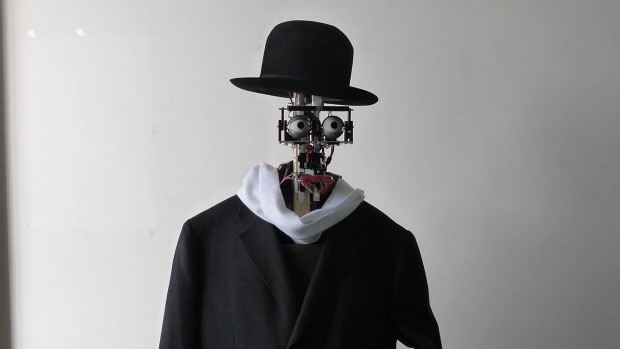Wednesday 02nd March 2016Robot Artists

Another week goes by, and another story trumpeting robotic artwork comes to supposedly dazzle us. Recently we discussed the Instapainting robot that drew based on a collaborative Twitch stream, and techies across the net were fascinated by the interplay. It was fairly interesting, of course, but as a collaborative art project rather than as a dire warning that robots are soon going to be replacing human artists.
This week, we bring to your attention a robot created by Google's Creative Lab that is able to create a pencil line drawing of a photographic portrait taken by a phone camera. It's an interestingly quirky piece of tech, but hardly something that can really be called an artist, despite what the gadget-hungry internet would like you to believe.
The robot is really just a Nexus 6P smartphone attached to a device known as a IOIO (yo yo) that enables it to move a pencil up and down the canvas by contracting and releasing two cables. But all of the interpretive work, in other words all the elements that actually make up a portrait, are handled by the application that converts your photo into an on-screen line drawing. While it might have a chance at replacing a boardwalk caricature artist on sheer novelty alone, it hardly seems likely that it will ever create something that will hang on a gallery wall.
But that's not to say that it's the last word on the potential of robot artists.
As artificial intelligence becomes one of the hottest areas of scientific research thanks to some actual, tangible leaps forwards in the field (think IBM's Watson winning at Jeopardy or Google's Deepmind AlphaGo beating the world's best Go player in 4 out of 5 matches), we may actually begin to see some true attempts to create an artificial artist. Many people around the world are concerned about robots replacing them in their field - McDonalds fast food workers, for example - but is this really going to ever be a concern for the art world?
Perhaps the better question is what will happen to the creative arts in a world where menial labour is all handled by machine intelligences, leaving us with a glorious excess of free time to work on whatever may catch our fancy.
Posted on March 02nd 2016 on 04:37am
0 Comments
Wednesday 10th February 2016Berenson Lives (?)
The late American art critic Bernard Berenson was widely regarded as one of the most authoritative experts on the Old Masters, that rather pompously-named group of European artists who had their respective heydays before the turn of the 19th century. He passed away in 1959, but not before creating a vast body of work regarding his chosen passion, the correct attribution of artworks. There is some controversy over his accuracy, or at least his motives, in this field, but we'll leave that for another post.
Fast-forward to present day, where a new Berenson has taken up the mantle of art criticism - or at least, taken up its bowler hat. Throughout the halls of the Musée du quai Branly in Paris a behatted robot strolls, examining the artwork, and formulating 'opinions' about them. Brainchild of robotics engineer Philippe Gaussier and anthropologist Denis Vidal, Berenson is a reactive system that uses its understanding of other's emotions as a gauge for forming his own opinions.
It (or should we say he?) watches the reactions of fellow museum visitors and sorts them into positive or negative, and then blends these reactions to decide whether or not it likes a certain piece.
"When he likes something, he goes in this direction and smiles. When he does not like, he goes away and he frowns – that's how it works. Basically, the idea is by doing so, it adapts itself to its environment, on the basis of this artificial taste, and the aim is to develop a robot that's the equivalent of aesthetic exploration of the world and to see if because of that it may adapt itself more easily to the world around and make other things on this basis," Vidal explains.
"So he developed his own knowledge of the world, which no other robot will have. So if you put different [versions] of them, they will have different ways of exploring the world. So what we are doing now is we develop different robots with different tastes, artificial tastes, and we try to see if because of that they may explore the world around them in more interesting ways."
Curiously enough, it seems like naming the robot after the deceased critic is a token of respect, but Berenson the man may very well have derided his robotic doppelganger as a piece of new media trash, as far removed from the business of actual art criticism as it is possible to be. Unfortunately for the man, the robot is here now, and rather dashing in his bowler hat.
Posted on February 10th 2016 on 02:33pm
0 Comments
 Another week goes by, and another story trumpeting robotic artwork comes to supposedly dazzle us. Recently we discussed the Instapainting robot that drew based on a collaborative Twitch stream, and techies across the net were fascinated by the interplay. It was fairly interesting, of course, but as a collaborative art project rather than as a dire warning that robots are soon going to be replacing human artists.
Another week goes by, and another story trumpeting robotic artwork comes to supposedly dazzle us. Recently we discussed the Instapainting robot that drew based on a collaborative Twitch stream, and techies across the net were fascinated by the interplay. It was fairly interesting, of course, but as a collaborative art project rather than as a dire warning that robots are soon going to be replacing human artists. The late American art critic Bernard Berenson was widely regarded as one of the most authoritative experts on the Old Masters, that rather pompously-named group of European artists who had their respective heydays before the turn of the 19th century. He passed away in 1959, but not before creating a vast body of work regarding his chosen passion, the correct attribution of artworks. There is some controversy over his accuracy, or at least his motives, in this field, but we'll leave that for another post.
The late American art critic Bernard Berenson was widely regarded as one of the most authoritative experts on the Old Masters, that rather pompously-named group of European artists who had their respective heydays before the turn of the 19th century. He passed away in 1959, but not before creating a vast body of work regarding his chosen passion, the correct attribution of artworks. There is some controversy over his accuracy, or at least his motives, in this field, but we'll leave that for another post.



